DPSSレーザー、532 nm
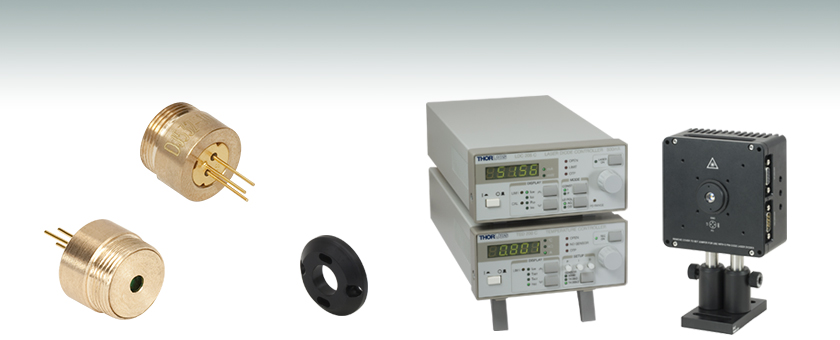
- 532 nm DPSS Lasers
- 10 mW or 40 mW Power Output
- Ø9.5 mm Package with M9 x 0.5 Threading
- Hermetically Sealed Package
Front
Rear
LDM56DJ
DPSS Laser
Mounting Flange
Application Idea
Our Laser Diode Driver Kits Include an
LD Controller, TEC Controller,
LD/TEC Mount, and Accessories
DJ532-10
532 nm, 10 mW

Please Wait

特長
- 出力:532 nm
- 出力パワー:10 mWまたは40 mW (CW)
- ビーム広がり角:12 mrad
- M9 x 0.5ネジ付き
- 標準のØ5.6 mm半導体レーザと同じピン間隔
- 温度制御付きマウント LDM56/Mに対応
当社の532 nm小型半導体励起固体(DPSS)緑色レーザーモジュールは、808 nmの半導体レーザで励起したNd:YVO4とKTP結晶を組み合わせたものです。出力部(前面)ウィンドウには、ウェッジガラスフィルタがはめ込まれており、赤外光をブロックしモジュールを密閉しています。DPSSレーザは、一般的な半導体レーザと同じように使用できますが、ビームの広がり角はかなり小さくなります。DPSSレーザはCW動作用で、パルス用ではありません。
こちらのレーザは、取付フランジ(下記)を使用すれば当社の温度制御付きレーザーマウント LDM56/Mに取り付け可能です。レーザ結晶は温度変化に敏感であるため、動作温度範囲(20~25°C)外では、動作効率が低くなります。ヒートシンク等による放熱がない場合、励起レーザ電流によって25°Cをかなり超えて熱くなります。
温度が調整されているDPSSレーザでは、当社のあらゆるM9ネジ付き非球面レンズアダプタがご使用いただけます。アダプタS1TM09の使用により幅広い種類のSM1ネジ付き部品が取り付けられます。筐体のネジなしの部分は、コリメーターアダプタAD9.5F内に固定することが可能です。なお、レーザを取り付けた場合、レーザーピンと発光ビームの間にはXY位置のオフセットがあることにご留意ください。当社の半導体レーザは筐体の中心に発光ビームがくるよう製造されています。M9ネジ付き面ではなく、ピンに合わせて取り付けた場合、ビームはマウントの中心より若干ずれて発光されます。詳しくは当社までお問い合わせください。
適切な性能を得るためには、半導体レーザのレーザ取り扱い手順を全て守ってください。DJ532-10(10 mW)のモニタ電流は、赤外域励起レーザのパワー値のみを示しており、DPSS緑色レーザの出力値ではありません。そのためDJ532-10は、定電流半導体レーザードライバとの使用をお勧めしています。またDJ532-40にはフォトダイオードモニタは付属しておりませんのでご注意ください。
レーザの安全性とクラス分類
レーザを取り扱う際には、安全に関わる器具や装置を適切に取扱い、使用することが重要です。ヒトの目は損傷しやすく、レーザ光のパワーレベルが非常に低い場合でも障害を引き起こします。当社では豊富な種類の安全に関わるアクセサリをご提供しており、そのような事故や負傷のリスクの低減にお使いいただけます。可視域から近赤外域のスペクトルでのレーザ発光がヒトの網膜に損傷を与えうるリスクは極めて高くなります。これはその帯域の光が目の角膜やレンズを透過し、レンズがレーザーエネルギを、網膜上に集束してしまうことがあるためです。
安全な作業および安全に関わるアクセサリ
- クラス3または4のレーザを取り扱う場合は、必ずレーザ用保護メガネを装着してください。
- 当社では、レーザのクラスにかかわらず、安全上無視できないパワーレベルのレーザ光線を取り扱う場合は、ネジ回しなどの金属製の器具が偶然に光の方向を変えて再び目に入ってしまうこともあるので、レーザ用保護メガネを必ずご使用いただくようにお勧めしております。
- 特定の波長に対応するように設計されたレーザ保護眼鏡は、装着者を想定外のレーザ反射から保護するために、レーザ装置付近では常に装着してください。
- レーザ保護眼鏡には、保護機能が有効な波長範囲およびその帯域での最小光学濃度が刻印されています。
- レーザ保護カーテンやレーザー安全保護用布は実験室内での高エネルギーレーザの遮光にご使用いただけます。
- 遮光用マテリアルは、直接光と反射光の両方を実験装置の領域に封じ込めて外に逃しません。
- 当社の筺体システムは、その内部に光学セットアップを収納し、レーザ光を封じ込めて危険性を最小限に抑えます。
- ピグテール付き半導体レーザは、他のファイバに接続、もしくは他のファイバとの接続を外す際には、レーザ出力をOFFにしてください。パワーレベルが10 mW以上の場合には特にご注意ください。
- いかなるビーム光も、テーブルの範囲で終端させる必要があります。また、レーザ使用中には、研究室の扉は必ず閉じていなければなりません。
- レーザ光の高さは、目線の高さに設定しないでください。
- 実験は光学テーブル上で、全てのレーザービームが水平を保って直進するように設定してください。
- ビーム光路の近くで作業する人は、光を反射する不要な装飾品やアクセサリ(指輪、時計など)をはずしてください。
- レンズや他の光学装置が、入射光の一部を、前面や背面で反射する場合がありますのでご注意ください。
- あらゆる作業において、レーザは必要最小限のパワーで動作するようにご留意ください。
- アライメントは、可能な限りレーザの出力パワーを低減して作業を行ってください。
- ビームパワーを抑えるためにビームシャッタや フィルタをお使いください。
- レーザのセットアップの近くや実験室には、適切なレーザ標識やラベルを掲示してください。
- クラス3Rやクラス4のレーザ(安全確保用のインターロックが必要となるレーザーレベルの場合)で作業する場合は、警告灯をご用意ください。
- ビームトラップの代用品としてレーザービュワーカードを使用したりしないでください。
レーザ製品のクラス分け
レーザ製品は、目などの損傷を引き起こす可能性に基づいてクラス分けされています。国際電気標準会議(The International Electrotechnical Commission 「IEC」)は、電気、電子工学技術関連分野の国際規格の策定および普及を行う国際機関で、IEC60825-1は、レーザ製品の安全性を規定するIEC規格です。レーザ製品のクラス分けは下記の通りです
| Class | Description | Warning Label |
|---|---|---|
| 1 | ビーム内観察用の光学機器の使用を含む、通常の条件下での使用において、安全とみなされているクラス。このクラスのレーザ製品は、通常の使用範囲内では、人体被害を及ぼすエネルギーレベルのレーザを発光することがないので、最大許容露光量(MPE)を超えることはありません。このクラス1のレーザ製品には、筐体等を開かない限り、作業者がレーザに露光することがないような、完全に囲われた高出力レーザも含まれます。 |  |
| 1M | クラス1Mのレーザは、安全であるが、望遠鏡や顕微鏡と併用した場合は危険な製品になり得ます。この分類に入る製品からのレーザ光は、直径の大きな光や拡散光を発光し、ビーム径を小さくするために光を集束する光学素子やイメージング用の光学素子を使わない限り、通常はMPEを超えることはありません。しかし、光を再び集光した場合は被害が増大する可能性があるので、このクラスの製品であっても、別の分類となる場合があります。 |  |
| 2 | クラス2のレーザ製品は、その出力が最大1 mWの可視域での連続放射光に限定されます。瞬目反射によって露光が0.25秒までに制限されるので、安全と判断されるクラスです。このクラスの光は、可視域(400~700 nm)に限定されます。 |  |
| 2M | このクラスのレーザ製品のビーム光は、瞬目反射があるので、光学機器を通して見ない限り安全であると分類されています。このクラスは、レーザ光の半径が大きい場合や拡散光にも適用されます。 |  |
| 3R | クラス3Rのレーザ製品は、直接および鏡面反射の観察条件下で危険な可視光および不可視光を発生します。特にレンズ等の光学機器を使用しているときにビームを直接見ると、目が損傷を受ける可能性があります。ビーム内観察が行われなければ、このクラスのレーザ製品は安全とみなされます。このクラスでは、MPE値を超える場合がありますが、被害のリスクレベルが低いクラスです。可視域の連続光のレーザの出力パワーは、このレベルでは5 mWまでとされています。 |  |
| 3B | クラス3Bのレーザは、直接ビームを見た場合に危険なクラスです。拡散反射は通常は有害になることはありませんが、高出力のクラス3Bレーザを使用した場合、有害となる場合もあります。このクラスで装置を安全に操作するには、ビームを直接見る可能性のあるときにレーザ保護眼鏡を装着してください。このクラスのレーザ機器にはキースイッチと安全保護装置を設け、さらにレーザ安全表示を使用し、安全照明がONにならない限りレーザがONにならないようにすることが求められます。Class 3Bの上限に近いパワーを出力するレーザ製品は、やけどを引き起こすおそれもあります。 |  |
| 4 | このクラスのレーザは、皮膚と目の両方に損傷を与える場合があり、これは拡散反射光でも起こりうるとみなされています。このような被害は、ビームが間接的に当たった場合や非鏡面反射でも起こることがあり、艶消し面での反射でも発生することがあります。このレベルのレーザ機器は細心の注意を持って扱われる必要があります。さらに、可燃性の材質を発火させることもあるので、火災のリスクもあるレーザであるとみなされています。クラス4のレーザには、キースイッチと安全保護装置が必要です。 |  |
| 全てのクラス2以上のレーザ機器には、上記が規定する標識以外に、この三角の警告標識が表示されていなければいけません。 |  | |
| Posted Comments: | |
Emeric Biver
(posted 2025-07-22 15:50:24.443) I have bought 2 DJ532-40 laser diodes and analyzed their emission spectrum (visible OSA). For one diode, it is possible to find temperature and current conditions (24.8 deg C / 330 mA) to have only one emission peak at 532 nm, which is important for our interference application. But for the second diode, it's impossible to get a single peak, always several ones (scanned 20 to 25 degC and 300 to 400 mA). Is that normal behavior? Did we get lucky for diode #1? Or unlucky for diode #2? Should we buy several diodes to hope to have one with a single peak, and what's the probability? EGies
(posted 2025-07-23 01:54:42.0) Thank you for contacting Thorlabs. The DJ532-40 diode having a single frequency is not a spec we test or guarantee, however it is often achievable with some combination of drive current and case temperature. I have reached out to you directly regarding this. John Jones
(posted 2025-07-18 10:24:52.103) I recently purchased the DJ532-10 laser diode, and I’ve noticed that the output appears diffused, with visible speckle patterns on my viewing screen. I’m unsure if this behavior is normal or if it could be improved by collimating the laser. Could you advise? skent
(posted 2025-07-25 11:15:36.0) Thank you for your feedback. A diffuse output could indicate an issue. I've reached out to you directly to discuss this further. user
(posted 2025-07-05 08:29:14.677) Hello thorlabs, I bought the DJ532-10 laser diode and the output that I get seems like it is going through a diffuser and I can see speckles in my viewing screen. I don’t know if that’s normal and could be solved collimating laser. bmandal
(posted 2025-11-03 09:40:10.0) Thank you for contacting Thorlabs. We have reached out to directly via email to discuss solutions for your specific applications. Li Zhang
(posted 2025-05-14 11:52:00.013) 没有这个半导体二极管的测量光谱,我无法确定其中心波长的具体FWHM实际是多少nm。 aprokofiew
(posted 2025-05-14 02:40:41.0) Hello Li, thank you for contacting Thorlabs. I have reached out to you directly to share available spectrum data for this laser diode. Stefano Condio
(posted 2025-04-24 12:01:05.893) Dear Thorlabs staff,
we just bought the 532nm laser DJ532-10 to perform
spectroscopy on a iodine vapour cell. We observed that approacching the recommended current value (200mA) the power emitted by the diode starts oscillating in amplitude at high frequency, making impossible to see a decent signal on the cell. We would like to ask you if it is a typical behaviour of if you think the laser is ruined. We mounted it on a LDM21 case, we pilot temperature and current with a TED200 and LDC210C and we paid attention to electric charges in the mounting phase.
Moreover we would like to ask you if it is safe scanning the emitted frequency by applying an external modulation on the diode current or on the temperature.
Have a nice day
Stefano Condio ksosnowski
(posted 2025-04-24 05:09:48.0) Hello Stefano, and thanks for reaching out to us. Oscillations like this in a constant power laser system are often a result of optical reflection feedback. This couples to the monitor photodiode which causes the driver to adjust the current level and can destabilize the laser cavity. Certain temperature and current combinations may also leave the diode closer to a mode-hop transition of the spectrum, and you may be able to find certain current levels that are more stable at your temperature. This does not particularly sound like a damaged laser however. Typically a permanent change in the threshold point or a sharp decrease in the operating power would be the main signs of optical damage. I have reached out directly to troubleshoot this setup further. Mike Pivnenko
(posted 2024-06-05 11:40:24.7) There is no information about polarisation of the output of DJ532-40 DPSS laser. Does it mean that the output in non polarised? Can it be used with a polariser?
Thnak you cdolbashian
(posted 2024-06-21 04:57:35.0) Thank you for reaching out to us with this inquiry,
These are not unpolarized. Internal tests yield a PER of approximately 5-10dB but it varies unit to unit. Additionally, the polarization direction direction is different per component.
You can certainly use this with a polarizer, and I would advise to align the polarization direction such that you have the maximum transmission, as there is a preferred inherent polarization direction from this diode (as mentioned above). Ozan A
(posted 2024-02-09 17:00:58.177) Greetings,
Can we tune the laser wavelenght with the temperature controllers? cdolbashian
(posted 2024-02-16 11:46:07.0) Thank you for reaching out to us with this inquiry. While the answer is technically yes, the tuning range would only be within the operating range of 20-25°C. You would likely only see <1nm of change to the center wavelength within the operating range. I have contacted you directly to discuss this. user
(posted 2024-02-07 10:52:35.937) Hi. I have a DJ532-40 with the LDM56DJ flange and the laser and TEC controller. I would like to send the laser output in optical single mode PM fiber (such as the P3-488PM-FC-2) to clean the mode and the polarizarion. Can you suggest a lens and optomechanics to perform properly the coupling? Also the other output of the fiber must be collimated in order to be sent to an optical confocal microscope. cdolbashian
(posted 2024-02-19 10:57:06.0) Thank you for reaching out to us with this inquiry. For standard application inquiries, we would recommend emailing your local support office. In this case, Europe@thorlabs.com. Additionally, I have contacted you directly to discuss your application. Lukas J
(posted 2023-07-24 11:07:47.407) Hello,
we've purchased the DJ532-40 together with the starter set LTC56A (current & temperature controller and mount). When we operate the laser at 24°C and 330mA, the output power of the laser drifts from 10 to 5 mW (measured after coupling to a fiber, absolute power is not an issue since we didn't align so far). After some time (5-30 min) the laser power starts to oscillate. Are you aware of cases where the output power oscillates visibly? What might cause this oscillation? Instability due to temperature (although we've set the temperature of the controller to 24°C)?
We're thinking of switching to a laser diode such as the 520 nm L520P50. Do you know whether we will encounter the same phenomen as well?
Best regards,
Lukas jpolaris
(posted 2023-07-31 06:41:58.0) Thank you for contacting Thorlabs. In order to isolate the issue to the laser and/or mount, the power should be measured directly from the output of the laser (prior to fiber coupling). If the instability issues are not present when measuring directly from the laser, then the fiber coupling technique can be examined. Common causes of instability are backreflections entering the laser and thermal issues. The DJ532-40 laser requires the LDM56DJ mounting flange to properly seat the laser into the LDM56 mount. If you are already using this flange, it would be a good idea to check that it is properly tightened. If the power is noticeably higher after turning off the laser and letting it cool, this is evidence of thermal issues. As for your question regarding stability of L520P50, we would not expect drift from either L520P50 or DJ532-40, assuming there were no backreflections entering these lasers, the correct flange was used, and the temperature was stable. I have reached out to you directly to assist in troubleshooting these instability issues. Emanuel Keller
(posted 2022-03-16 03:37:30.93) DJ532-40, polarisation axis
In the "532 nm Diode-Pumped Solid State (DPSS) Lasers, Overview"
You are stating:
"The polarization of the DJ532-10 laser is perpendicular to the line made by pins 1 and 3 (see pin diagrams below) while the DJ532-40 laser has a polarization that is parallel to this same line."
We however observe the maximum transmission trough a linear polarisation filter at some 23° - 27° off this axis.
The question already came up. Unfortunately it has not been answered publicly.
Do you have an explanation for this contradicting observation?
In case this matters, we attempt to drive the Laser with about 20mW output power.
Best Regards
Emanuel cdolbashian
(posted 2022-04-20 04:54:13.0) Thank you for sharing this information with us. Following this feedback, we have investigated the polarization of several of these units. We have found no consistent polarization direction, and after some discussion with the vendor we have found that this is to be expected. As of now we are removing statements on this page which present incorrect information regarding the predictability of the polarization direction of these diodes. We have reached out to you directly to discuss a refund for your device. user
(posted 2021-11-19 18:36:58.267) Which controller is recommended? it is possible to use the DPSS DJ532-10 and DJ532-40 lasers with one of the OEM Current and temperature controller. In particular with the
ITC110 OEM Laser Diode and Temperature Controller, ±1 A / 12 W YLohia
(posted 2021-11-23 02:04:53.0) Thank you for contacting Thorlabs. For our DPSS lasers we recommend using the LDC205C and TED200C controllers. That being said, any laser diode current controller capable of supporting the pin code, current, and voltage requirements can be used (such as the ITC110). user
(posted 2021-08-30 16:41:02.407) I am interested to a laser for Raman spectroscopy and microscopy. The critical factors to be considered are the low linewidth, wavelength variation with temperature and beam quality. Can you give me more information about these properties? Do you suggest these DPSS 532nm for Raman application? YLohia
(posted 2021-09-01 10:45:44.0) Thank you for contacting Thorlabs. We have, in the past, measured the linewidth to be 11 MHz for the 10 mW version and about 30 MHz for the 40 mW laser. Please note that these are not specs and are not guaranteed (and they are dependent on laser drive current and the temperature setpoint combination). We also have not determined the temperature tuning coefficient, but it is essential to the proper operation of this DPSS laser to be mounted on to a temperature-controlled mount anyway, especially if wavelength-stability is required. The laser emits a single mode TEM00 beam with a divergence of 12 mrad (typical). The laser can, in principle, be used for Raman spectroscopy, depending on your other components and your requirements for spatial and spectral resolution. Our own soon-to-be-released Raman spectroscopy kit uses the FPV785M laser for 785 nm excitation: https://www.thorlabs.com/newgrouppage9.cfm?objectgroup_id=14427&pn=FPV785M Deepa Kasaragod
(posted 2020-10-16 22:18:20.477) Can I please know the optical power stability information of DJ532-40. YLohia
(posted 2020-10-19 03:12:59.0) Thank you for contacting Thorlabs. Unfortunately, we do not spec stability for component laser diodes as this spec is dependent on the drive electronics, mounting, and temperature control of the diode. JIMMY CRAFTON
(posted 2020-04-27 11:02:14.217) I am looking to scan a molecular iodine transition. Have used other off-the-shelf DPSS products in the past (Coherent, etc.) Three questions.
1) Assuming this is a single mode laser with coherence length of a few meters?
2) What is the approximate line width (~100 MHz or less)
3) What is the thermal wavelength tuning coefficient (i.e. about 0.04 nm/C) YLohia
(posted 2020-05-07 09:21:02.0) Thank you for contacting Thorlabs. Measuring the DJ532-10 (200mA, 25C) with our SA200 Scanning Fabry Perot Interferometer, we calculated a linewidth of ~10.9MHz which translates to a coherence length of ~27.5m. Following a similar procedure with the DJ532-40 (330mA, 24C), we calculated ~30MHz linewidth for a coherence length of ~10m.
Since this is a DPSS laser, thermal tuning does not have an impact on the final 532 nm wavelength. These lasers are sensitive to temperature and can only operate optimally within a small range of 20-25 C. The temperature tuning coefficient of the 808 nm pump diode used in this is ~0.25 nm/C. Jack Vandermolen
(posted 2020-01-15 22:26:05.76) Hello. I noticed the beam divergences for most of your other laser diodes are in degrees and around 10 in terms of order of magnitude; however, for the DJ532-40 and DJ532-10, the beam divergence is listed at about 12 mrad, which is much smaller of course. Is this supposed to be the case or is that a measurement in degrees. I would like to know so I know whether I will need to colliminate the light or not. Thank you. YLohia
(posted 2020-01-16 10:04:19.0) Hello, thank you for contacting Thorlabs. The low beam divergence spec is correct -- this is an artifact of the DPSS design of the laser. The beam size is around Ø50µm at the output face of the crystal in the DPSS. The divergence is typically around 12 mrad (could be as high as 15 mrad) from that point on. So collimation may not be necessary, depending on your application and requirements. We have also seen very low divergences (less than 5 mrad) as well. Given that the divergences can be very low, placing a short focal length lens can result in the beam being focused to a spot. If necessary, you could look into using long focal length aspheric lenses (f >= 100 mm). Antonin Delas
(posted 2019-12-06 03:25:47.837) Good morning,
For my application, I need a more powerful green DPSS. Is it possible to only buy the 9.5mm package, and use a custom 808nm diode?
Would it work with high powers?
Thanks a lot YLohia
(posted 2019-12-10 08:49:04.0) Hello, thank you for contacting Thorlabs. I have reached out to you directly to discuss the possibility of offering this. katrin.philipp
(posted 2019-02-27 13:42:56.677) Hi, I am also interested in the spectrum of DJ532-40 diode lasers and the coherence length. Could you please send me the same information you sent to jxxu (posted 2019-02-21 09:51:02.0). Thank you! llamb
(posted 2019-02-28 09:51:38.0) Thank you for your feedback. I have reached out to you directly. jxxu
(posted 2019-02-20 23:05:38.177) Hi,
Do you have the spectrum of DJ532-40 diode lasers? I want to know the FWHM of the longitudinal mode and the coherence length of the laser.
Thanks! YLohia
(posted 2019-02-21 09:51:02.0) Hello, thank you for contacting Thorlabs. Measuring the DJ532-10 (200mA, 25C) with our SA200 Scanning Fabry Perot Interferometer we calculated a linewidth of ~10.9MHz which translates to a coherence length of ~27.5m. Following a similar procedure with the DJ532-40 (330mA, 24C) we calculated ~30MHz linewidth for a coherence length of ~10m. jact
(posted 2018-12-04 10:11:49.25) Can you give any details of the residual IR (specifically 1064, but also 808) emitted from the device? We would actually want to use the 1064 as a seed in a DFM stage, so are hoping there could still be a small but usable level transmitted. YLohia
(posted 2018-12-04 11:14:16.0) Hello, thank you for contacting Thorlabs. The IR leakage at 808nm and 1064nm is on the order of ~1.0 uW each, depending on the variant of the DJ532 model, though this is not something we specify. I will reach out to you directly with more information on how the test was conducted. user
(posted 2018-10-04 10:30:20.797) Is the laser diode controller TLD001 compatible with the DPSS laser DJ532-40? Thanks. YLohia
(posted 2018-10-04 10:48:42.0) Hello, we do not recommend the TLD001 for the DJ532-40 since the driver maxes out at an output current of 200mA. This diode, however, has a typical operating current of 330mA (400mA max). Thus, we recommend the LDC205C instead. deepak.korhalkar
(posted 2018-04-07 06:03:03.883) Please specify Model No. of the Aspheric Lens ( with mount ) that must be used to collimate the DJ532-10.
I guess the output power will be variable if we vary the drive current. Kindly confirm & send the graph if you have.
Thanks YLohia
(posted 2018-04-09 03:11:12.0) Response from Yashasvi at Thorlabs USA: Hello, thank you for contacting Thorlabs. The beam size is around Ø50µm at the output face of the crystal in the DPSS. The divergence is typically around 12 mrad (could be as high as 15 mrad) from that point on. We have seen very low divergences (less than 5 mrad) as well. Given that the divergences can be very low, placing a short focal length lens can result in the beam being focused to a spot. Keeping this in mind, for general use, we do not recommend the use of collimation optics. If necessary, you could look into using long focal length aspheric lenses. We have a tutorial for picking an appropriate lens for single mode laser diode collimation here: https://www.thorlabs.com/newgrouppage9.cfm?objectgroup_id=1832&tabname=LD%20Collimation. The typical Optical Power vs Drive Current plot can be found on the spec sheet available on the website. Please note that we do not recommend this diode for pulsed operation. Sasha
(posted 2018-03-19 22:04:12.687) What is M^2 and ellipticity of the dpss laser 10 mw? YLohia
(posted 2018-03-26 09:26:55.0) Hello, thank you for contacting Thorlabs. Unfortunately, we do not test individual units for their M^2 and ellipticity, so we don't really have a spec for this. That being said, in subjective terms, the beam is quite circular. I will reach out to you directly with the data we do have regarding this. stuart.mirell
(posted 2016-02-16 18:56:25.0) What is the typical polarization extinction ratio of the 532 nm DJ532-10 DPSS laser? besembeson
(posted 2016-03-09 01:37:41.0) Response from Bweh at Thorlabs USA: Though the pump and second harmonic generation process that generates the output are highly polarized in nature, the measured linear PER is only in the 5-10dB possibly due to some ellipticity that is introduced prior to the output. kwbchang2009
(posted 2015-10-06 23:51:16.29) do you have the noise data on the output for this diode
please call me at 408 799 3595
or email data to me
kwbchang2009@gmail.com besembeson
(posted 2015-10-13 11:43:28.0) Response from Bweh at Thorlabs USA. We don't have a typical noise data (amplitude or frequency) at this time. When using this, remember that it is a diode pumped laser with a frequency doubling crystal and the nonlinear effect is sensitive to temperature so besides using a very stable current source, the operating temperature should also be optimized within the specified range for single mode operation. hallt
(posted 2015-04-07 16:27:19.143) I would be really excited if you had a DPSS module such as this WITHOUT the KTP crystal. Any chance of getting one of those? jlow
(posted 2015-04-15 04:45:02.0) Response from Jeremy at Thorlabs: This is not a module we have. I will contact you directly regarding the possibility of getting this. user
(posted 2014-08-18 15:25:36.167) Hi Jeremy:
"The polarization direction of DJ532-40 is parallel to the line made by pins 1 and 3. "
Are you sure? I checked with mine and found that it's ~40 degrees from the pin1-3 direction (horizontal of TCLDM9). Am I doing something wrong? jlow
(posted 2014-08-21 03:18:35.0) Response from Jeremy at Thorlabs: Since you did not leave your contact info, please contact us at techsupport@thorlabs.com and we will troubleshoot this issue. Thanks. rsuper
(posted 2014-04-02 18:44:45.803) What is the polarization axis with respect to the packaging pin layout? jlow
(posted 2014-04-03 09:10:50.0) Response from Jeremy at Thorlabs: The polarization direction of DJ532-40 is parallel to the line made by pins 1 and 3. For the DJ532-10, it is perpendicular to the line made by pins 1 and 3. busko
(posted 2013-04-03 17:59:51.263) After using DJ532-40 round half a year it getting hard to obtain TEM00 mode. Some time ago it helped to change the temperature, or to play with a current, but now I have no more ideas.. Laser is mounted in TCLDM9. Could you give an advice? Or should we buy a new one? jlow
(posted 2013-04-11 09:37:00.0) Response from Jeremy at Thorlabs: The typical lifetime for the DJ532-40 is around 5000 hours or so. We will get in contact with you directly to discuss about your DJ532-40. barney.william
(posted 2013-02-12 11:36:50.31) I am interested in modulating this laser at about 400 Hz. I saw the comment posted below about crystal state lifetimes being a limitation, but there was no further information.
Also, can this laser be fiber-coupled? jlow
(posted 2013-02-14 15:36:00.0) Response from Jeremy at Thorlabs: For the DJ532 series, we do not recommend modulating this (only use as a CW source). The reason for this is because one cannot get clean output signal if modulated. For example, within a 5ms pulse, the output is quite noisy and erratic. Also, the output is non-linear (because of the non-linear crystal in the DPSS). You could possibly fiber couple this with the right optics and mount. tcohen
(posted 2013-01-10 10:52:00.0) Response from Tim at Thorlabs: This is correct. The LDM9T and LDM21 use a flange for the mount’s taps with a center distance of 20.32mm as opposed to the TCLDM9’s 19.05mm. We chose to introduce a flange for this mount as testing on the TCLDM9 with the DJ532 series showed it was able to dissipate the heat generated by the DPSS. bbattle
(posted 2013-01-04 10:14:43.61) The TCLDM9DJ mounting flange for LD DJ532-10 does not fit the LDM9T mount: the distance between mounting screws needs to be 20mm, but are 19mm. jlow
(posted 2012-11-01 11:12:00.0) Response from Jeremy at Thorlabs: The linewidth for the DJ532-40 should be around 30MHz. oriol.alvarez
(posted 2012-10-31 09:00:29.72) Hello,
I could not find the spectral characteristics of this product. In particular I am interested in the linwidth (which should be < 30 pm).
Can I have more information on this please?
Thank you in advance jlow
(posted 2012-09-04 14:26:00.0) Response from Jeremy at Thorlabs: The photocurrent from the monitor photodiode only represents the power of the 808nm pump laser diode and is not indicative of the optical power output of the 532nm laser. Typically, the DJ532 is used with a constant current source. For example, for an OEM solution, you could use the LD1255R (http://www.thorlabs.com/NewGroupPage9.cfm?objectgroup_id=1366&pn=LD1255R). olivier.hignette
(posted 2012-09-03 15:05:31.0) I do not see any information about the photodiode current of a DJ-532-10 which would allow me to set up the gain with a EK1102 evaluation kit sharrell
(posted 2012-06-07 14:16:00.0) Response from Sean at Thorlabs to busco: Thank you for your feedback. You are indeed correct, the vaule for P0 in the Operating Current and Operating voltage entries on the spec sheet and web spec table for the DJ532-40 should be 40 mW. We are correcting this error and the spec sheet and website should be updated soon. busko
(posted 2012-06-06 07:10:58.0) There is a small mistake in a spec sheet for DJ532-40: "Operating Current @ P0 = 10 mW*. "
Should be 40 mW. tcohen
(posted 2012-05-11 16:04:00.0) Update from Tim at Thorlabs: The beam waist is about 50um located at the surface of the crystal. After testing two DJ532-10 units, the output is elliptically polarized and both units have PER (the power ratio between the max power axis and min power axis) between 13dB to 14dB. Measuring the DJ532-10 (200mA, 25C) with our SA200 Scanning Fabry Perot Interferometer we calculated a linewidth of ~10.9MHz which translates to a coherence length of ~27.5m. Following a similar procedure with the DJ532-40 (330mA, 24C) we calculated ~30MHz linewidth for a coherence length of ~10m. Thank you for your interest in these DPSS laser diodes. We are continuing to characterize these and will update the web presentation with more information. tcohen
(posted 2012-05-09 12:11:00.0) Response from Tim at Thorlabs: Thank you all for your feedback. We are working to update the web presentation in the near future to provide more information. For your immediate needs I will compile this data and update you shortly. ihp
(posted 2012-05-08 05:43:36.0) What is the coherence length of the DJ532-10?
Ib holmlid
(posted 2012-05-07 10:40:43.0) What is the polarization state of the laser beam from this DJ532 laser? tcohen
(posted 2012-04-19 12:05:00.0) Response from Tim at Thorlabs: Thank you for your feedback! There are a few things that may alter the performance of the DPSS when modulating the pump diode. Because the DJ532 has a laser diode which pumps a crystal, the lifetime of the energy states of the crystal will likely limit modulation speed. Also, the response is highly non-linear which will cause uneven pulses. I will contact you to continue this discussion. busko
(posted 2012-04-18 12:53:31.0) Could this laser be modulated by the current modulation (for example with pulse-peaker and TCLDM9 mount) or it is mostly designed for CW usage? gao53
(posted 2012-03-31 09:51:20.0) May I know the output beam diameter of this LD? Thanks. gao53
(posted 2012-03-30 11:01:05.0) What is the coherence length of this laser diode? bdada
(posted 2012-03-15 15:03:00.0) Response from Buki at Thorlabs:
Thank you for your feedback. The beam diameter is about 60um (FWHM) at the crystal surface which is about 1.35mm inside the device’s front window.
We are currently revising the specification sheet for this laser in order to provide more information.
Please contact TechSupport@thorlabs.com if you have additional questions. user
(posted 2012-03-12 11:30:03.0) What are the beam diameters (FWHM) for your DPSS laser modules? As the divergence is so small that becomes quite important. bdada
(posted 2011-12-29 11:53:00.0) Response from Buki at Thorlabs:
I would like to correct my former response. While the pin out of the DPSS laser is compatible with our temperature controlled mounts, we do not currently have a mounting flange designed to hold the DPSS laser in our temperature controlled mounts. We are working on making the mounting flange available soon. As a temporary solution, we can provide a custom mounting flange.
Please contact TechSupport@thorlabs.com if you have any questions. bdada
(posted 2011-12-27 15:40:00.0) Response from Buki at Thorlabs:
Thank you for your feedback. The DPSS lasers are compatible with our TCLDM9 temperature controlled mount. Please contact TechSupport@thorlabs.com if you have additional questions. user
(posted 2011-12-24 11:39:19.0) Is the DPSS laser compatible with your TCLDM9 or other LD mount in "Related Products" linked above? bdada
(posted 2011-11-03 16:59:00.0) Response from Buki at Thorlabs:
We have visible collimated laser modules that may be better suited to your alignment needs. Please use the link below to get more information:
http://www.thorlabs.com/NewGroupPage9.cfm?ObjectGroup_ID=1487&pn=CPS532#368
The DJ532-10 is a bare diode that will require a laser driver as well as a lens to get a collimated beam. We have contacted you to discuss your application and assist you in selecting the appropriate products. iain
(posted 2011-11-03 11:11:27.0) Would this laser (DJ532-10) be suitable as an alignment laser for a telescope? (It would need to be visible at a distance of about 50 m, and attenuated for safety.)
Does it require a specific power supply? Can it be operated from a battery? |

| Item # | DJ532-10 | DJ532-40 | ||||
|---|---|---|---|---|---|---|
| Min | Typical | Max | Min | Typical | Max | |
| Wavelength | 531 nm | 532 nm | 533 nm | 531 nm | 532 nm | 533 nm |
| Optical Output Power | - | 10 mW | 20 mW | - | 40 mW | 50 mW |
| Operating Current @ Poa | - | 220 mA | 250 mA | - | 330 mA | 400 mA |
| Operating Voltage @ Poa | - | 1.9 V | 2.2 V | - | 1.9 V | 2.2 V |
| Slope Efficencya | 0.1 W/A | 0.2 W/A | - | 0.1 W/A | 0.2 W/A | - |
| Beam Divergence, Full Angle | - | 12 mrad | 15 mrad | - | 12 mrad | 15 mrad |
| Pin Code | A | E | ||||
| LD Reverse Voltage (Max) | 2 V | 2 V | ||||
| Operating Temperature | 20 to 25 °C | 20 to 25 °C | ||||
| Storage Temperature | -30 to 70 °C | -30 to 70 °C | ||||
| Pin Diagramb |  |  | ||||

取付けフランジLDM56DJは、532 nm DPSSレーザを温度制御付きマウントLDM56/Mに取付けるために使用します。使用する際は、レーザDJ532-10またはDJ532-40をマウントLDM56/Mに取り付けます。フランジかマウント自体に付いている2つの2-56×3/8"のキャップスクリュで、マウントにフランジを取付けます。
注:こちらのフランジは温度制御付き半導体レーザーマウントLDM56/Mには付属しておりません。
 Products Home
Products Home











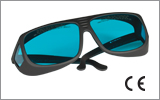
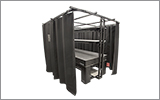
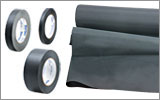
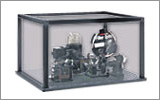
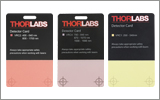
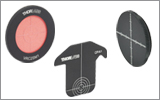
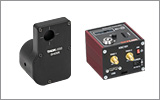
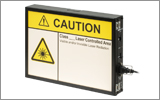
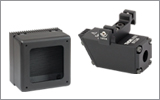
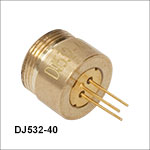
 ズーム
ズーム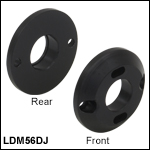
 532 nm半導体レーザ
532 nm半導体レーザ